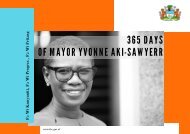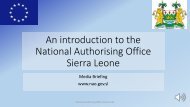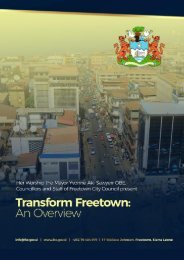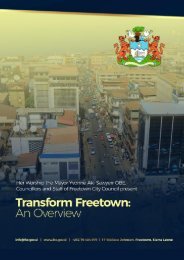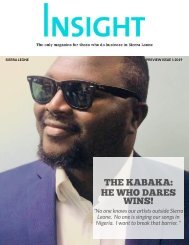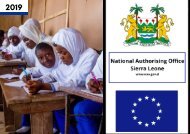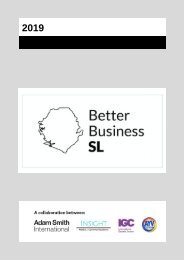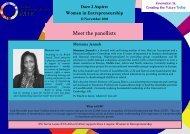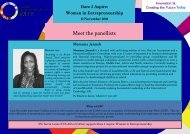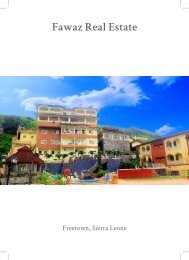The Sierra Rutile Review 2 2013
Written and produced for our client - Sierra Rutile Ltd
Written and produced for our client - Sierra Rutile Ltd
You also want an ePaper? Increase the reach of your titles
YUMPU automatically turns print PDFs into web optimized ePapers that Google loves.
SEPTEMBER <strong>2013</strong><br />
CREATING A WORLD CLASS<br />
WORKFORCE<br />
June saw the launch of <strong>Sierra</strong> <strong>Rutile</strong>’s ground-breaking Localisation Plan -<br />
an accelerated career development pathway for the company’s most<br />
talented <strong>Sierra</strong> Leonean employees, which will prepare them for jobs as<br />
supervisors, managers and top technicians within the organisation.<br />
SIERRA RUTILE’S NEW DRY MINING<br />
PLANT AT LANTI ACHIEVES<br />
MAXIMUM OUTPUT<br />
<strong>Sierra</strong> <strong>Rutile</strong>’s new dry mining plant at Lanti, has completed its performance<br />
testing and is now operating at full capacity.<br />
At a special briefing on the company’s Localisation Plan, CEO John Sisay<br />
said: “At <strong>Sierra</strong> <strong>Rutile</strong>, we are proud to be able to say that 95% of our<br />
employees are <strong>Sierra</strong> Leone nationals. Even so we have been able to<br />
identify clear opportunities to increase the numbers of <strong>Sierra</strong> Leonean<br />
employees in our organisation, particularly in our supervisory, technical<br />
and managerial positions. Our Localisation Plan will ensure that we make<br />
the most of these opportunities.”<br />
<strong>The</strong> Localisation Plan also ensures that the company meets its obligations<br />
under the 2009 Mines and Minerals Act and the recently introduced<br />
Local Content Policy. Furthermore it contributes substantially towards<br />
the pool of technical and managerial skills within the country as a whole.<br />
Key to its success is the new Performance Management System<br />
introduced within <strong>Sierra</strong> <strong>Rutile</strong>, which provides managers with a<br />
structured and impartial method of assessing employees against Key<br />
Performance Indicators (KPIs) related to production, health and safety,<br />
development and company values amongst others. Employees whose<br />
performance and potential are rated highly against these KPIs are<br />
described as ‘high potential’ or HiPos for short.<br />
Tailored development plans are created, aimed at fast-tracking HiPos into<br />
important technical, supervisory and management roles within the<br />
company. <strong>The</strong>se plans identify skills needs; supply learning opportunities<br />
through formal study, short courses and on the job training; and provide<br />
mentoring from <strong>Sierra</strong> <strong>Rutile</strong>’s senior management team.<br />
John Sisay says: “<strong>Sierra</strong> <strong>Rutile</strong>’s Localisation Plan is challenging and will<br />
require the hard work, support and commitment of many people within<br />
our organisation, as well as externally. However, as an organisation with<br />
a tradition of identifying and developing talented employees, we have<br />
first-hand experience demonstrating that the time and effort invested in<br />
training and development contributes towards the economic growth and<br />
sustainable development of both <strong>Sierra</strong> <strong>Rutile</strong> and <strong>Sierra</strong> Leone.”<br />
<strong>The</strong> performance testing, which was handled by contracting firm -<br />
Consulmet, as well as <strong>Sierra</strong> <strong>Rutile</strong>’s Projects and Operations teams,<br />
consisted of running feed continuously through both feed preparation<br />
circuits and the rest of the plant for 168-hours. Throughout the process, the<br />
team recorded and measured feed and product tonnages, and collected<br />
samples to monitor metallurgical efficiency.<br />
<strong>The</strong> objective of the test was to demonstrate the ability of the plant to<br />
achieve the name plate design of 500 tonnes per operating hour (tpoh) of<br />
run of mine (ROM) feed through the system. <strong>The</strong> system had to sustain this<br />
throughput at 90% availability over a 168 hour period. In fact during the<br />
performance testing process, the concentrator operated at an average feed<br />
rate of 522 tph, exceeding the design specifications of 500 tph.<br />
<strong>The</strong> mining operation and the concentrator plant are both currently<br />
operating in excess of their design rate of 3.5 million tonnes per annum<br />
and, so far, have not been significantly affected by the rains. <strong>The</strong> project is<br />
forecast to contribute 30,000 - 35,000 tonnes of rutile out of <strong>Sierra</strong> <strong>Rutile</strong>’s<br />
<strong>2013</strong> expected total rutile production of 125,000 tonnes.<br />
Commenting on the achievement of the dry mining concentrator’s<br />
nameplate capacity, Desmond Williams, <strong>Sierra</strong> <strong>Rutile</strong>’s Operations Manager<br />
said: “<strong>The</strong> ramp-up of the Lanti Dry Mining project to its full capacity and the<br />
successful accomplishment of the performance testing process has required<br />
the intensive and co-ordinated effort of the teams involved, and we are<br />
delighted with the success of their hard work.”<br />
SIERRA RUTILE’S MINING LAKES<br />
TRANSFORMED INTO FISH FARMS<br />
THE SIERRA RUTILE FOUNDATION<br />
GETS NEW STEERING COMMITTEE<br />
CLEARING LAND AND SUPPLYING<br />
SAND FOR COMMUNITY PROJECTS<br />
Communities around <strong>Sierra</strong> <strong>Rutile</strong>’s mining operations gathered together at<br />
the end of July to help harvest and release 50,000 tilapia and cat fish into<br />
man-made lakes once dredged for rutile. <strong>The</strong> young fish are part of <strong>Sierra</strong><br />
<strong>Rutile</strong>’s expanding fish farming initiative which aims to rehabilitate its<br />
obsolete dredge ponds into alternative sources of revenue, employment<br />
and food.<br />
<strong>Sierra</strong> <strong>Rutile</strong>’s approach to rehabilitating mined land, balances social and<br />
community needs with environmental considerations so that rehabilitated<br />
land can become equally, if not more, valuable to local communities.<br />
<strong>The</strong> economic potential of aquaculture in <strong>Sierra</strong> Leone has already been<br />
widely identified. A recent overview of <strong>Sierra</strong> Leone’s aquaculture sector,<br />
by the UN’s Food and Agriculture Organisation, concluded that its potential<br />
for food security, employment and household income generation still<br />
remains to be properly exploited. Furthermore, the Government’s recently<br />
launched Agenda for Prosperity aims to increase the supply of fish for the<br />
domestic market by at least 15% annually, particularly from semi-industrial,<br />
artisanal, inland and aquaculture fisheries activities.<br />
<strong>Sierra</strong> <strong>Rutile</strong>’s aquaculture programme began in 1990. Ansumana Jabati,<br />
<strong>Sierra</strong> <strong>Rutile</strong>’s Environment, Health and Safety Manager, explains that “it<br />
was arrived at after a series of stakeholder consultations aimed at<br />
identifying the needs of surrounding communities, and examining how<br />
out-of-use dredge ponds could become significant and sustainable<br />
economic opportunities.”<br />
<strong>The</strong> project has been increasingly successful, with the number of young fish<br />
released more than doubling from 73,953 in 2011 to an expected 180,000<br />
in <strong>2013</strong>. <strong>The</strong> company has also started to experiment with native fish such<br />
as cutlass and electric fish, sourced from the nearby Mokaba<br />
Fisherwomen’s Group.<br />
Andy Taylor, <strong>Sierra</strong> <strong>Rutile</strong>’s Head of Operations says: “It is important that<br />
our mining operations leave a lasting and positive legacy. In countries such<br />
as Australia, Canada and Brazil, turning the man-made lakes caused by<br />
mining into fish farms has become an acceptable method of land<br />
rehabilitation. We hope that we can achieve similar success with <strong>Sierra</strong><br />
<strong>Rutile</strong>’s aquaculture programme.”<br />
<strong>Sierra</strong> <strong>Rutile</strong> recently welcomed a new Steering Committee to the <strong>Sierra</strong><br />
<strong>Rutile</strong> Foundation, and thanked the Foundation’s outgoing committee for<br />
its service.<br />
<strong>The</strong> <strong>Sierra</strong> <strong>Rutile</strong> Foundation, a non-profit organisation funded by <strong>Sierra</strong><br />
<strong>Rutile</strong>, was set up over six years ago by the company to handle community<br />
development in the areas surrounding its operations.<br />
Its new Steering Committee is headed by Madam Rita N'gardi Savage,<br />
Chair of Bonthe District Council. Also on the committee is Paramount<br />
Chief Hon. Alhaji Alie Badara Sheriff III of Jong Chiefdom and Paramount<br />
Chief John Jibao Russell-Nyaama III of Lower Banta Chiefdom, as well<br />
Bagruwa Chiefdom’s youth leader and the women’s leader of Imperi<br />
Chiefdom.<br />
Commenting on her appointment to the position of Chair of the <strong>Sierra</strong><br />
<strong>Rutile</strong> Foundation Steering Committee, Madam Rita N’gardi Savage said:<br />
“It is with great pleasure that I have accepted the position of Chair of the<br />
<strong>Sierra</strong> <strong>Rutile</strong> Foundation. <strong>The</strong> <strong>Sierra</strong> <strong>Rutile</strong> Foundation offers a real<br />
opportunity to significantly move socio-economic development forward in<br />
the mining communities in this area and I look forward to working with my<br />
colleagues on initiatives that will have a positive and sustainable impact.”<br />
<strong>The</strong> new Committee has already agreed a programme of community<br />
development, with initiatives including solar street lighting and community<br />
water tanks.<br />
When <strong>Sierra</strong> <strong>Rutile</strong>’s considerable haulage fleet is not being used for<br />
rutile mining, some of its vehicles may be found doing double duty on<br />
community projects.<br />
Chief among them is the big D9, a 47- tonne dozer with a 410 HP engine<br />
which makes light work of even the toughest jobs, as several villages,<br />
who have witnessed the speed with which it clears land for roads,<br />
playing fields and schools, can attest.<br />
Clearing land is usually done by hand. It is back-breaking and often<br />
dangerous work that can take weeks. <strong>The</strong> D9 however can clear an acre<br />
in little over an hour and <strong>Sierra</strong> <strong>Rutile</strong> has used it to clear land for a<br />
number of schools and playing fields including those at Torkpoi,<br />
Madina, Matagelema and Mosanesi, as well as the Children of the<br />
Nations orphanage at Ngolala.<br />
<strong>Sierra</strong> <strong>Rutile</strong>’s tipper trucks can also be seen out and about providing<br />
sand and mud for community building projects. This year alone the<br />
company has delivered well over 35 trips. <strong>The</strong> most unusual request,<br />
however, was for the use of a crane with an operator to unload a 40<br />
foot shipping container of school equipment, which <strong>Sierra</strong> <strong>Rutile</strong> also<br />
transported the 140 miles from Freetown to Madina.






